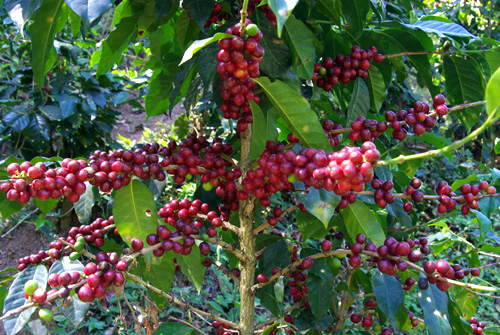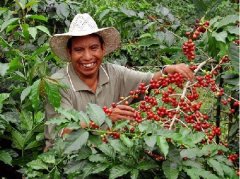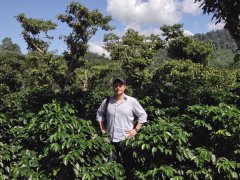An introduction to the five major coffee producing areas in Guatemala

For professional baristas, please follow the coffee workshop (Wechat official account cafe_style)
Guatemalan coffee beans smell like peanut cookies, very special, this time also brewed two rounds, the result is the second win, the notes are as follows
Guatemala 1
For the first time
The bean grinder tiamo700s scale 4, grind 16 grams of powder, 200CC water, water temperature 88 C, pour 200CC water into the pot of smart filter cup, then pour coffee powder, with a stirring stick, mix well in about 10 seconds, mix in 25 seconds, mix in 40 seconds, and drain coffee in 45 seconds.
Result: the palate is not so full on the palate, with citrus acidity and malt aroma in the mouth, but the taste fades in the end, and the level is not so distinct. Maybe the temperature can be a little higher about 90 degrees.
Guatemala 2
The second time
The bean grinder tiamo700s scale 3.5, grind 15 grams of powder, water temperature 90 degrees c, coffee powder into a smart filter pot, clockwise into the 40CC water, soak for 30 seconds and then continue to pour into the water 225CC, then soak for 2 minutes, and finally the coffee out of 195CC.
Result: the palate is fuller than the first round, with sour citrus aromas on the palate and will return sweet after swallowing.
Win for the second time in Guatemala this week! Will continue to try different coffee beans in the future!
Guatimala introduces the five major coffee producing areas in Guatemala:
Population: 15438000
Guatemala has been more successful in defining its coffee priority areas than most countries and has developed markets with very different sales models. According to my experience, coffee in this area has the same flavor characteristics, but it has not been explicitly stated so far.
SAN MARCOS
San Marcos San Marcos is the warmest and wettest coffee growing area in Guatemala. On the hillside facing the Pacific Ocean, the rainy season comes earlier, so the flowering time is earlier than usual. Rainfall has a great influence on post-harvest drying, so some farms use a mixture of sun and mechanical drying at the same time. In the region, agriculture is the mainstay of the economy and also produces food, fruit, meat and wool.
Altitude: 1300 Murray 1800m
Harvest: December-March
Variety: bourbon, Caturra,Catuai
ACATENANGO
The coffee production area of the Akernango region revolves around the Arcatel Nangot Valley, named after the volcano. In the past, many producers sold coffee to coyotes, through which the fruit was exported to the Antigua region and processed there. This is because Antigua coffee has a good reputation and can be sold at a higher price. This practice is not very common now, since the coffee produced in the Arcatel Nango specialty area produces excellent coffee beans and has become more and more widely recognized, making the coffee beans in the area not only profitable but also traceable.
Altitude: 1300-2000m
Harvest: December-March
Variety: bourbon, Caturra,Catuai
ATITLAN
The Attland Coffee Farm is located around Lake Attilan. Located at 1500 meters (4900 feet) above sea level, the lake has captured the hearts of many writers and tourists because of its incredible beauty over the years. Strong winds are common here in the late morning and early afternoon, and locals call them "xocomil", meaning "the wind that takes away sin". Here, some private nature reserves have been set up to protect the biodiversity of the area and to help prevent deforestation. Due to rising labor costs and labor competition, coffee production is under pressure. Urban expansion has also increased pressure on land use, with some farmers finding it more profitable to sell their land than to continue to grow coffee.
COBAN
Before World War II, German coffee producers took control of the region, and the town of Koban was named after this history of growth and prosperity. The dense tropical rain forest climate pattern creates a very humid climate, which is a challenge for coffee drying. The area is difficult and expensive to transport because of its geographical location, however, there is still amazing coffee from the area.
Altitude: 1300-1500m
Harvest: December-March
Variety: bourbon, Maragogype,Catuai,Caturra,Pache
ANTIGUA
Antigua is probably the best-known coffee producing region in Guatemala, as well as one of the best-known countries. The area, named Antigua, is home to famous Spanish buildings and UNESCO World Heritage sites. Because the market was previously flooded with pirated coffee beans that devalued Antigua coffee, the coffee beans in the area were originally named "authentic Antigua Coffee" in 2000. However, this has not completely curbed the pirated coffee beans imported from abroad and processed locally. In spite of this, in addition to those overpriced fakes, coffee beans of good quality and worth tracing, as well as coffee beans that do come from Antigua, can be traced back to the source.
Altitude: 1500-1700m
Harvest: January-March
Variety: bourbon, Catuai,Caturra
Important Notice :
前街咖啡 FrontStreet Coffee has moved to new addredd:
FrontStreet Coffee Address: 315,Donghua East Road,GuangZhou
Tel:020 38364473
- Prev

Coffee characteristics, uses and Coffee producing areas in Guatemala & output, production and Marketing of Coffee products over the years
For the exchange of professional baristas, please pay attention to the coffee workshop (Wechat official account cafe_style) Guatemala is located in the north of Central America, west and north of Mexico, east of Belize and the Caribbean, southeast of Honduras and El Salvador, south of the Pacific Ocean. Topography: the terrain of Guatemala changes obviously and can be divided into three major parts: the northern lowland: Petn region, at an altitude of 20000.
- Next

ERGOS COFFEE operator Carlos Pascual, pioneer of Guatemala boutique coffee movement
Carlos Pascual, the operator of the ERGOS brand in Taiwan, takes Taiwan as the starting point, gradually overcomes cultural differences, establishes a network, and wins long-term cooperation from more than 200 manufacturers in Taiwan with unique customer service. At first glance, the brand name of ERGOS immediately reminds me of the meaning that may be related to environmental protection. Carlos Pascual, the operator of the brand in Taiwan, explained
Related
- Detailed explanation of Jadeite planting Land in Panamanian Jadeite Manor introduction to the grading system of Jadeite competitive bidding, Red bid, Green bid and Rose Summer
- Story of Coffee planting in Brenka region of Costa Rica Stonehenge Manor anaerobic heavy honey treatment of flavor mouth
- What's on the barrel of Blue Mountain Coffee beans?
- Can American coffee also pull flowers? How to use hot American style to pull out a good-looking pattern?
- Can you make a cold extract with coffee beans? What is the right proportion for cold-extracted coffee formula?
- Indonesian PWN Gold Mandrine Coffee Origin Features Flavor How to Chong? Mandolin coffee is American.
- A brief introduction to the flavor characteristics of Brazilian yellow bourbon coffee beans
- What is the effect of different water quality on the flavor of cold-extracted coffee? What kind of water is best for brewing coffee?
- Why do you think of Rose Summer whenever you mention Panamanian coffee?
- Introduction to the characteristics of authentic blue mountain coffee bean producing areas? What is the CIB Coffee Authority in Jamaica?

